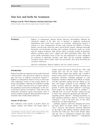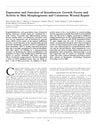Search
forLearn
4 / 4 resultslearn Thymosin Beta 4
learn Low Level Laser Therapy
laser therapy for anti-inflammatory and likely insignificant hair regrowth effects
learn Osteopontin
signaling protein that, when suppressed, may grow hair by reducing inflammation and stem cell loss
Research
5 / 1000+ resultsresearch Epithelial Expression of the Hormone Leptin by Bovine Skin
Cattle skin has leptin which might control skin and hair growth.

research Synergistic Antibacterial Activity and Wound Healing Properties of Selenium-Chitosan-Mupirocin Nanohybrid System: An In Vivo Study on Rat Diabetic Staphylococcus Aureus Wound Infection Model
The nanohybrid system significantly improved wound healing and showed strong antibacterial activity.

research Hair Loss and Herbs for Treatment
Herbs can potentially treat hair loss by inhibiting a key enzyme and promoting hair growth, and deficiencies in zinc, biotin, and iron are linked to hair loss.
research Divergent Roles of HDAC1 and HDAC2 in the Regulation of Epidermal Development and Tumorigenesis
HDAC1 is crucial for skin development and preventing tumors.

research Expression and Function of Keratinocyte Growth Factor and Activin in Skin Morphogenesis and Cutaneous Wound Repair
KGF and activin are crucial for skin healing and repair.
Community Join
5 / 97 resultscommunity 4 months, only Minoxidil 5% ,dermarolling twice a week. hair growth results. any suggestions?
Significant hair growth was achieved using Minoxidil 5% and dermarolling twice a week, with suggestions to add finasteride for maintenance. There is debate on when to apply Minoxidil after dermarolling to avoid irritation.
community PP405: The Ultimate Hair Loss Drug for Complete Hair Growth
PP405 is a new hair loss treatment in phase 2 trials that may promote hair growth by increasing lactate production and activating hair follicle stem cells. It could potentially replace hormone-disrupting treatments like Minoxidil and finasteride.
community Vitamin C and hair growth PH levels
The conversation is about using vitamin C and Magnesium L-Threonate for hair growth by reducing DHT binding to dermal papilla cells. The original post about vitamin C's pH levels and sebum control was possibly removed by a moderator.
community Confused why people are calling PP405 a cure...it never claimed to be able to undo miniaturization or revert vellus back to terminal hairs. It seems to be more of a growth stimulant like minoxidil.
PP405 is not a cure for hair loss but may reactivate dormant hair follicles, similar to minoxidil. It is unlikely to help with miniaturized or vellus hairs and is still in trial phases, with availability expected around 2030.
community People who don’t microneedle, why?
Microneedling is often combined with minoxidil for hair growth, but concerns about scalp damage, pain, and effectiveness deter some users. Alternatives like finasteride, dutasteride, tretinoin, and laser treatments are preferred by others.